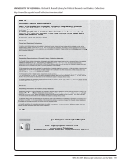102 · Survey Results: Survey Questions and Responses
There is far more use of our materials
from patrons around the world. E-mail
requests for publication rights to
reproduce images from our materials
has soared.
This allows for 24-hour access to our
materials at any desktop or laptop
computer.
It lessens the need to handle the
original items.
This provides our users a way to search
our manuscript collections--they’ve
never been able to do this before.
Having finding aids and collection
information on the Web brings users to
our Web site who may never have come
there otherwise.
It’s making our reference work a little
easier. Patrons now email, call, or
come in person to see a collection and
already know the exact box they need
in a collection. This gives our reference
staff more time to help other patrons.
Use of EAD enables collocation of cross
institutional search results.
Patrons arrive at the repository with
accurate descriptive information,
reducing the time needed for the
reference interview.
Brief descriptions on the Web enable
us to demonstrate the value of our
collections and create opportunities for
external support when individuals need
prompt access to materials.
Visibility for researchers. Visibility for library staff. Trying to create a union catalog of
finding aids for all archives.
Wider audience. Easier to search digital formats better
reference quality.
Promotes preservation.
Wider availability. Access. Control of resources.
Usage Tracking
29. Does the library track the usage of either print or online finding aids? Check all that apply. N=64
Yes No
In-house finding aids 9 51
Online finding aids 28 34
If yes, please briefly describe the tracking method.
In-house finding aids tracking method N=10
“Circulation use of our in-house printed finding aids. Check out records of our manuscript collections.”
“Hard copy use forms filled out by patrons.”
“Keep statistics from paper records.”
There is far more use of our materials
from patrons around the world. E-mail
requests for publication rights to
reproduce images from our materials
has soared.
This allows for 24-hour access to our
materials at any desktop or laptop
computer.
It lessens the need to handle the
original items.
This provides our users a way to search
our manuscript collections--they’ve
never been able to do this before.
Having finding aids and collection
information on the Web brings users to
our Web site who may never have come
there otherwise.
It’s making our reference work a little
easier. Patrons now email, call, or
come in person to see a collection and
already know the exact box they need
in a collection. This gives our reference
staff more time to help other patrons.
Use of EAD enables collocation of cross
institutional search results.
Patrons arrive at the repository with
accurate descriptive information,
reducing the time needed for the
reference interview.
Brief descriptions on the Web enable
us to demonstrate the value of our
collections and create opportunities for
external support when individuals need
prompt access to materials.
Visibility for researchers. Visibility for library staff. Trying to create a union catalog of
finding aids for all archives.
Wider audience. Easier to search digital formats better
reference quality.
Promotes preservation.
Wider availability. Access. Control of resources.
Usage Tracking
29. Does the library track the usage of either print or online finding aids? Check all that apply. N=64
Yes No
In-house finding aids 9 51
Online finding aids 28 34
If yes, please briefly describe the tracking method.
In-house finding aids tracking method N=10
“Circulation use of our in-house printed finding aids. Check out records of our manuscript collections.”
“Hard copy use forms filled out by patrons.”
“Keep statistics from paper records.”








































































































































































































